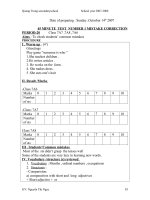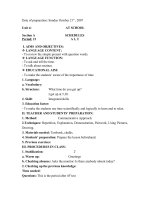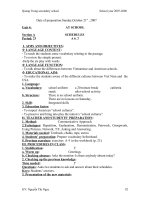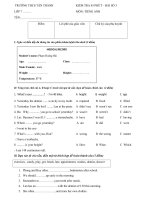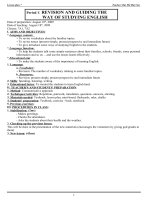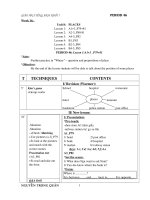Tiếng Anh 7 ( Tiết 1-5)
Bạn đang xem bản rút gọn của tài liệu. Xem và tải ngay bản đầy đủ của tài liệu tại đây (223.35 KB, 22 trang )
Lesson plan 7 Teacher: Bui Thi Hai Van
Period 1: REVISION AND GUIDING THE
WAY OF STUDYING ENGLISH
Date of preparation: August 10
th
, 2009
Date of teaching: August 18
th
, 2009
Classes: 7A1, 7A2
I. AIMS AND OBJECTIVES:
* Language content:
+ To revise vocabulary about the familiar topics.
+ To revise tenses (present simple, present progressive and immediate future)
+ To give introduce some ways of studying English to the students.
* Language function:
+ To help the students talk some simple sentences about their families, schools, friends, some personal
information and so on …and use the tenses learnt effectively.
* Educational aim:
+ To make the students aware of the importance of learning English.
1. Language
a. Vocabulary:
+ Revision: The number of vocabulary relating to some familiar topics.
b. Structures:
+ Revision: present simple, present progressive and immediate future
2. Skills: Speaking, listening, writing.
3. Educational factor: To remind the students to learn English hard.
II. TEACHER'S AND STUDENTS' PREPARATION:
1. Method: Communicative approach
2. Techniques/Activities: Repetition, pairwork, translation, questions -answers, eliciting.
3. Materials needed: Textbook, lesson plan, mini-board, flashcards, ruler, chalks
4. Students' preparation: Textbook, exercise - book, notebook.
5. Previous exercises:
III. PROCEDURES IN CLASS:
1. Stabilization: (2ms)
- Makes greetings.
- Checks the attendance.
- Asks the students about their health and the weather.
2. Checking up the previous lesson.
This will be done in the presentation of the new materials (encourages the volunteers by giving god grades to
them)
3. New lesson: (43ms)
1
Lesson plan 7 Teacher: Bui Thi Hai Van
Teaching
steps &
time
Teacher's activities Students' activities
The lesson content
I. Presenta-
tion of the
new
materials
(39ms)
(6ms)
10ms
(4ms)
(3ms)
A. REVISION:
1. Lead - in:
* Sets the situations.
- Asks the students to answer some
questions:
+ What do you do?
+ What does your father do?
+ How old are you?
+ What are you doing now?
+ Do you like our school?
+ What are you doing tomorrow?
- Remarks the students' answers.
* Introduces the aims of the lesson:
"You've answered the questions using the
different tenses. Today we've revised the
tenses: present simple, present
progressive and immediate future, and
learn some ways of studying English from
your friends to improve your English.''
2. Pre - practice:
a. Present simple tense:
- Gives some sentences and asks the
students to draw the form.(hangs the sub -
board)
+ I am a student.
+ My father is a teacher.
+ They are teachers.
+ We like our school.
+ I and my younger sister have breakfast
at 6 o'clock.
+ My father has dinner at 5.30 pm.
- Gives the form:
* to be: S + am / is / are + …
* ordinary verbs: S+V/ V-s / V-es …
* to have: S+ have/ has +….
- Asks the students to give its usage
- Retells the usages: "The present simple
tense is used to talk about a daily
happening event."
- Asks the students to change the
sentences above into the negative and
interrogative form.
b. Present progressive tense:
- Asks the students to draw the form of
this tense from the sentences.
- Says to the class:
+ '' I'm explaining the lesson to you.
You're listening to me. But Hoa is writing
the lesson. And we're studying English
now."
- Answer the teacher.
+ I am a student.
+ He's a farmer./ worker/
…
+ I'm 13.
+ I'm studying English.
+ Yes, I do.
+ I'm going to do the
housework.
- Listen to the teacher.
- Listen to the teacher.
- Look at the sentences
on the sub - board.
- Read the sentences and
draw the form of the
tenses.
Form: S+ V/V-s/ V-es
- Copy down in their note
book.
- Gives its usages.
- Write down.
- Change the sentences
into the interrogative and
negative form.
+ I'm not a student.
+ My father isn't a
teacher.
+ They aren't teachers.
+ We don't like our
school.
+ I and my younger
sister don't have
breakfast at 6 o'clock.
+ My father doesn't have
dinner at 5.30 pm.
- Draw the form of this
tense from the sentences.
- Listen to the teacher
and draw the form.
A.REVISION:
1. Present simple
tense:
a. form:
* to be: S +
am / is / are
…
* ordinary
verbs: S+ V /
V-s / V-es…
* to have: S+
have/has….
b. Usages: "The
present simple tense is
used to talk about a
daily happening
event."
2. Present
progressive tense:
a. Form:
S + am / is
/are + V-ing
b. Usage: '' It's used to
express an action or an
event happening at the
time of speaking."
3. Immediate future
tense:
a. Form:
… be going to
+ V( bare
infinitive)
b. Usage: It's used to
express a plan in the
near future.
* Exercise:
Key:
a. Lan and I are doing
the homework now.
b. My sister usually
gets up at 5 o'clock.
c. What are you going
to do tomorrow
morning?
d. He doesn't watch
TV before dinner.
2
Lesson plan 7 Teacher: Bui Thi Hai Van
(3ms)
(12ms)
(6ms)
- Gives the form:
S + am / is /are + V-ing
- Asks the students to say the negative
and interrogative form.
- Asks them to say its usage again.
- Says its It's used to express a plan in the
near future. '' It's used to express an action
or an event happening at the time of
speaking."
c. Immediate future tense:
- Gets the students to retell the form of
the structure used to express the
immediate future.
- Gives the structure :
… be going to + V( bare infinitive)
- Says to them: "It's used to express a
plan in the near future."
3. Controlled practice:
- Asks the students to complete the
sentences with the correct form of the
verbs in the brackets
a. Lan and I (do) the homework now.
b. My sister usually (get) up at 5 o'clock.
c. What you (do) tomorrow morning?
d. He (not/ watch) TV before dinner.
e. Hoa (visit) Hue next month.
f. My mother (be) a good teacher.
- Calls some students to give their answer
in front of the class.
- Corrects some mistakes.
- Gives the remarks and marks to the
students.
4. Free practice:
- Has the students work in pairs to ask
and answer about the following topics.
* Personal information.
* Your family
* Your hobby.
Ex: 1. A: What's your name?
B: My name is …….
A: How old are you?
B: I'm 13
A: Where do you live?
B: I live in……..
2. A: What does your father do?
B: He's a doctor.
A: How many there in your family?
B: There are 3(4) people in my family.
- Remarks.
B. INTRODUCING SOME WAYS OF
STUDYING ENGLISH.
- Tells the students why they need to find
S + am / is /are + V-ing
* negative form:
- S + am / is /are + not +
V-ing
* interrogative form
- Am / is /are + S + V-
ing?
- Say its usage again.
- Listen to the teacher.
- Retell the form of the
structure used to express
the immediate future.
…be going to + V( bare
infinitive)
- Listen to the teacher.
-Do the exercise.
a. Lan and I are doing the
homework now.
b. My sister usually gets
up at 5 o'clock.
c. What are you going to
do tomorrow morning?
d. He doesn't watch TV
before dinner.
e. Hoa is going to visit
Hue next month.
f. My mother is a good
teacher.
- Give their answer in
front of the class.
- Listen to the teacher.
- Work in pairs to ask and
answer about the topics
given.
- Practice in pairs in front
of the class.
- Listen to the teacher.
e. Hoa is going to visit
Hue next month.
f. My mother is a good
teacher.
B. INTRODUCING
SOME WAYS OF
STUDYING
ENGLISH.
+ Save time
+ Grasp the
knowledge carefully.
+ Bring joys / interest
in English.
+ Do the test well and
get good / high grades.
+….
3
Lesson plan 7 Teacher: Bui Thi Hai Van
(5ms)
III.Consolid
ation: (4ms)
III.
Homework(
5ms)
out a good method of studying English.
+ Save time
+ Grasp the knowledge carefully.
+ Bring joys / interest in English.
+ Do the test well and get good / high
grades.
+….
- Asks some good students to give their
method of studying English to the whole
class.
- Shows some ways of studying English.
+ Vocabulary.
+ Grammar
+ Skills ( speaking, listening, reading,
writing)
- Emphasizes the revision to be important
and necessary.
- Asks some situational questions to get
the answers which are the main points of
the lesson.
- Reminds the students of the importance
of self- studying.
- Asks the students to revise the basic
knowledge which they have just revised
in the lesson ( tenses, structures, …)
- Asks them to prepare for the next
lesson (unit 1: A1, A2 Friends)
- Give their method of
studying English to the
whole class.
- Listen to the teacher.
- Listen to the teacher.
- Answers which are the
main points of the lesson.
- Listen to the teacher.
- Listen to the teacher.
- Listen to the teacher.
* SELF -EVALUATION:
……………………………………………………………………………………………………………………
……………………………………………………………………………………………………………………
……………………………………………………………………………………………………………………
……………………………………………………………………………………………………………………
……………………………………………………………………………………………………………………
……………………………………………………………………………………………………………………
4
Lesson plan 7 Teacher: Bui Thi Hai Van
Unit 1: BACK TO SCHOOL
Period 2: A1 + A2. FRIENDS
Date of preparation: August 13
rd
, 2009
Date of teaching: August 19th,2009
Classes: 7A1, 7A2
I. AIMS AND OBJECTIVES
* Language content:
+ To introduce the students with some expressions of greetings and some new words expressing
characteristic.
+ To help the students revise the words about school and friends.
+ To make the students master the present simple tense, comparative and usage of the phrase " a lot of/
many + N".
* Language function:
+ To help the students create conversations to greet and introduce one another.
+ To enable the students to practice reading the text for details
+ To help the students know to make comparison between 2 schools or 2 places …
* Educational aim:
+ To make the students aware of the love for schools, teachers and friends
1. Language:
a. Vocabulary:
+ New words: nice to see you again, nice to meet you, so am I, classmate,
new, different, unhappy
meet
b. Structures:
+ Revision: present simple
Comparison
A lot of/many + Noun
2. Skills: Speaking, listening, reading (scanning), writing.
3. Educational factor: + To encourage the students to be proud of their schools, teachers, friends make
friendships with newcomers
+ To remind them to keep their school cleaner and more beautiful.
II. TEACHER'S AND STUDENTS' PREPARATION:
1. Method: Communicative approach
2. Techniques/Activities: Repetition, situation, prefix, game, pairwork, groupwork, translation, questions and
answers,..
3. Materials needed: Textbook, lesson plan, cassette and tape, pictures, mini-board, flashcards, ruler, chalks
4. Students' preparation: Textbook, exercise - book, notebook.
5. Previous exercises:
III. PROCEDURES IN CLASS:
1. Stabilization: (2ms)
- Makes greetings.
- Checks the attendance.
- Asks the students about their health and the weather.
2. Checking up the previous lesson. (5ms)
A. Answer the questions: (6pts)
1. Where do you live? 2. What time do you usually get up?
3. What do you do after school? 4. Do you like warm weather?
B. Complete the sentences with the correct form of the verbs in the brackets.(4pts)
1. She often (go) ……….. to the cinema on the weekends.
2. We (read) ………….. book now.
5
Lesson plan 7 Teacher: Bui Thi Hai Van
* Answer key:
A. 1. I live in My Quang…. 2. I get up at 6 o'clock. 3. I play soccer. 4. Yes, I do./ No, I don't.
B. 1. goes 2. are reading
3. New lesson: (38ms)
Teaching
steps &
time
Teacher's activities Students' activities
The lesson content
I. Presenta-
tion of the
new
materials
(29ms)
(13ms)
2ms
4ms
I. A1:
1. Lead - in:
* Sets the situations.
- Asks the students what they said to their
close friends when they first saw one
another.
- Asks some questions:
+ Do you have any new friends this
school year?
+ What do you say to your friends when
the first meet after the summer holiday?
+ Are you happy to be back again?
- Asks the students to look at the picture
and answer "Who are the students?
( picture A1) / What are they doing?''
* Tells the aim of the lesson:
''Today we're going to learn unit 1: Back
to school. Now begin with A1: Friend to
know some expressions to greet and
introduce one another"
2. Pre - practice:
a. Teach new words:
- Teaches word by word following the
steps and principles of teaching words.
* New words:
+ nice to see you again: (situation)
- Says to the students "I taught you
English last year. This is the firs t time I
saw you again. I say " nice to see you
again"
+ nice to meet you: (situation)
- Says to the students "This is the new
student in our class. I say to him: nice to
meet you"
- Lets the students listen and repeat the
phrase in chorus, in groups and
individually and guess its meaning from
the context.
+ new (antonym)
- Asks the students to look at the two
pens: One is old and the other is new.
- Says to the students "This pen is old and
that one is new."
- Lets the students listen and repeat "new"
many times.
- Asks the students "what is the antonym
of "old"? and gets them to guess its
- Answer the teacher.
+ Yes.
+ Do you happy in your
summer holiday?
+ Yes.
- Look at the picture and
answer "They are Ba, Nga
and Hoa."
- Listen to the teacher.
- Listen, repeat, guess the
meaning of the words from
the techniques of teaching
vocabulary and copy down.
nice to see you again: rất
vui được gặp lại bạn
nice to meet you: Rất
hân hạnh được gặp bạn
new (adj):: mới
* A1:
1. New words:
+ nice to see you
again: /
…………………
…………………
……./: rất vui
được gặp lại bạn
(đã quen nhau)
+ nice to meet you
:/
…………………
……./ : Rất hân
hạnh được gặp bạn
(Đây là lần đầu gặp
nhau)
+ new /
………………../
(adj): mới
+ classmate /
…………………
……/ (n): bạn cùng
lớp
+ so am I : tôi cũng
6
Lesson plan 7 Teacher: Bui Thi Hai Van
1m
4ms
2ms
meaning.
new (adj): mới
+ classmate:(explanation)
- Says "You all are classmates."
- Gets the students to listen and repeat the
words many times.
- Explains the word.
"classmate" means the friends who is in
the same class."
- Lets them guess the meaning.
classmate (n): bạn cùng lớp
+ so am I (translation):tôi cũng vậy
- Explains the structure to the students.
so am I : Tôi cũng vậy
* Checks the understanding of the words
by asking them to play the game ''slap the
board''
b. Revises the present simple tense of
"to be":
- Lets them gives some examples.
Ex:
• I am in class 7A.
• This is our new classmate.
• They are new students.
- Revises the simple present of " to be"
3. Controlled practice:
- Asks the students to look at the pictures
and listen to the dialogue twice.
- Asks the to repeat the dialogue in chorus
- Has them practice the dialogue a in
groups of three and change their roles.
- Asks them to practice the dialogue b in
pairs and take turns.
- Calls on some groups to reads the
dialogue a & b in front of the class.
- Corrects the mistakes.
- Asks them to read the questions in the
textbook and answer the questions.
* Questions:
a. What is the new girl's name?
b. What class is she in?
c. Who is also in class 7A?
- Calls on some pairs to ask and answer in
the front of the class.
4. Free practice:
- Asks the students to make similar
conversations to greet and introduce one
another (work in groups)
- Calls some students to go to the board
and act out their dialogues in front of the
class.
II. A2:
1. Lead - in:
classmate (n): bạn cùng
lớp
so am I : Tôi cũng vậy
- Play the game "slap the
board"
- Revises the simple present
of "to be"
- Give some examples.
- Listen and write down.
- Look at the pictures and
listen to the dialogue twice.
- Repeat the dialogue in
chorus.
- Practice the dialogue a in
groups of three and change
their roles.
- Practice the dialogue b in
pairs and take turns.
- Reads the dialogue a&b in
front of the class.
- Read the questions in the
textbook and answer the
questions.
a. Her name is Hoa.
b. She's in class 7A.
c. Nam is also in class
7A.
- Ask and answer in the
front of the class.
- Work in groups to make
similar conversations to
greet and introduce one
another.
- Go to the board and act out
their dialogues in front of
the class.
vậy
tôi cũng vậy
2. The present
simple tense of
"to be":(revision)
Ex:
- I am in class 7A.
- This is new our
classmate.
- They are new
students.
3. Answer the
questions:
* Key:
a. What is the new
girl's name?
Her name is
Hoa.
b. What class is she
in?
She's in class
7A.
c. Who is also in
class 7A?
Nam is also in
class 7A.
7
Lesson plan 7 Teacher: Bui Thi Hai Van
(16ms)
2ms
4ms
1m
3ms
* Sets the situation:
- Asks the students to look at the pictures
and answer the questions.
+ Who is the girl?
+ How many schools are there in the
picture?
+ Which school is bigger?
* Introduces the new lesson.
"Hong Ha is Hoa's new school and the
smaller is her old one. Now you read the
passage and answer the questions to
understand more about Hoa's schools."
2. Pre - practice:
a. Teach new words:
- Teaches word by word following the
steps and principles of teaching words.
* New words:
+ different (situation)
- Gives out two white chalks and says
"They are not different." And hands a
colorful chalk instead of the white chalk
and says: "They are different."
- Lets the students listen and repeat the
word many times and guess the meaning
of the words.
different (adj): khác, khác nhau
+ unhappy (prefix):
- Draws the two faces on the board: one is
happy and the other is unhappy.
- Says to the students "An is happy and
Hoa is unhappy''
an hoa
- Lets the students listen, repeat and guess
its meaning-
unhappy (adi):không vui, không hạnh
phúc
+ miss (situation)
- Lets the students listen and repeat the
word many times and guess the meaning
of the words.
miss (v): nhớ
Ex: I miss my parents when I am away
from home.
* Checks the understanding of the words
by asking them to do the activity '' rub- out
and remember''
b. Revises the present simple tense of
ordinary verbs:
Ex: She misses her parents and friends.
c. True - false statement prediction.
1. Hoa is from Hue.
2. She lives with her parents in Ha
Noi.
3. She has a lot of friends in Ha
- Look at the pictures and
answer the questions.
+ She's Hoa.
+ There are two.
+ Hong Ha is bigger.
- Listen to the teacher.
- Listen, repeat, guess the
meaning of the words from
the techniques of teaching
vocabulary and copy down.
different (adj): khác,
khác nhau
unhappy (adi):không vui,
không hạnh phúc
miss (v): nhớ
- Do as the teacher asks.
- Revise it.
1.T 2F 3F/T 4T/F 5F
II. A2:
1. New words:
+ different /
…………………
…../ (adj): khác,
khác nhau
+ unhappy /
…………………..
/ (adi):không vui,
không hạnh phúc
+ miss /
……………./ (v):
nhớ
Ex: I miss my
parents when I am
away from home.
2. Revises the
present simple
tense of ordinary
verbs:
Ex: She misses her
parents and friends.
8
